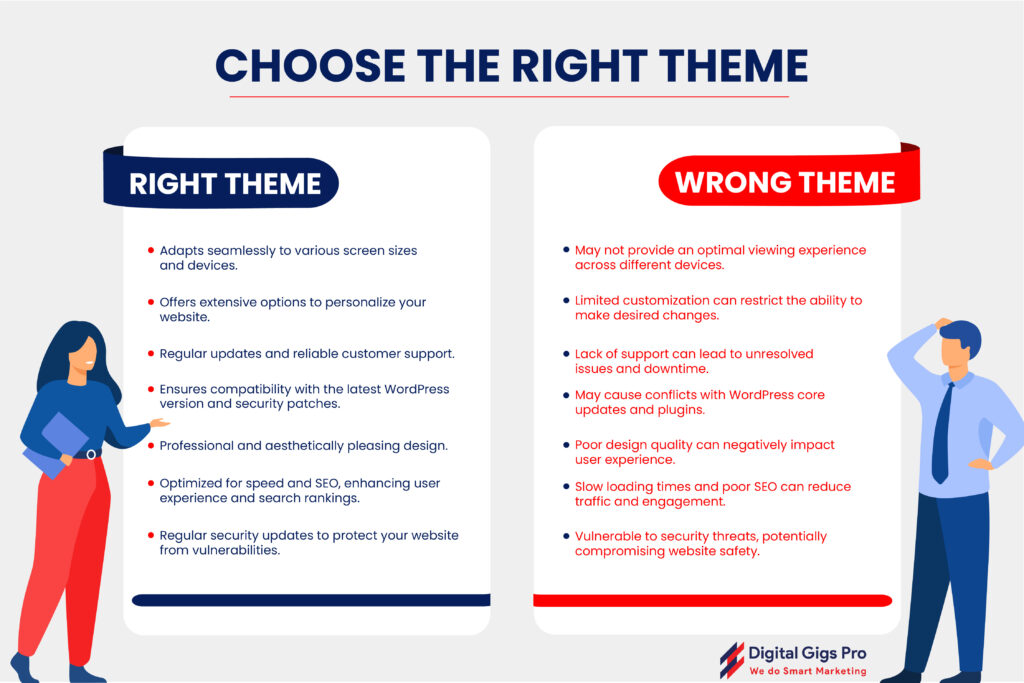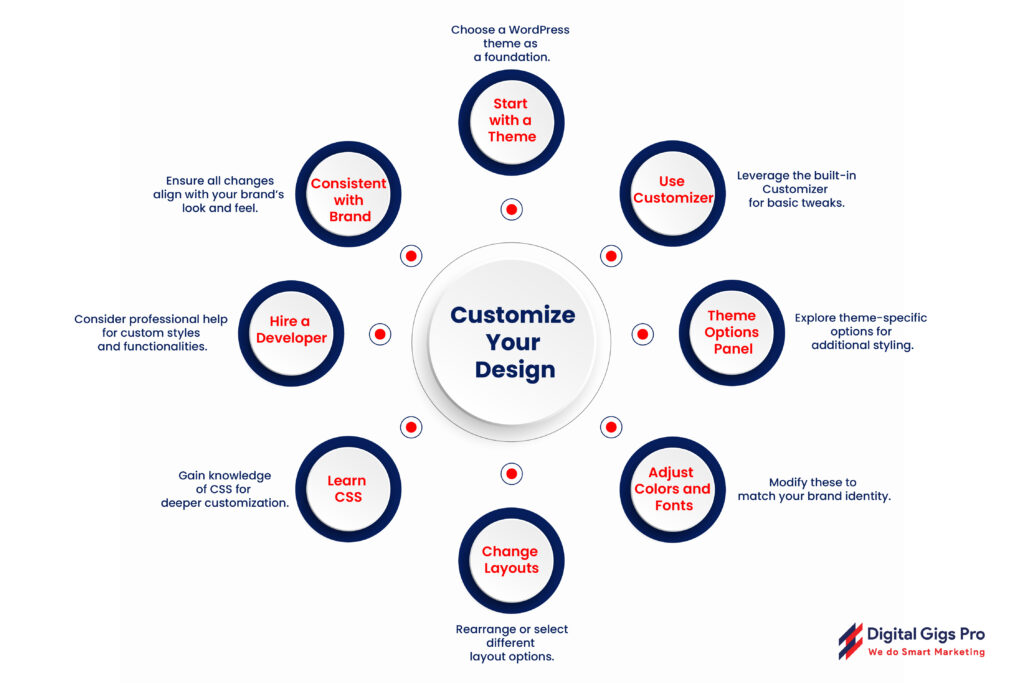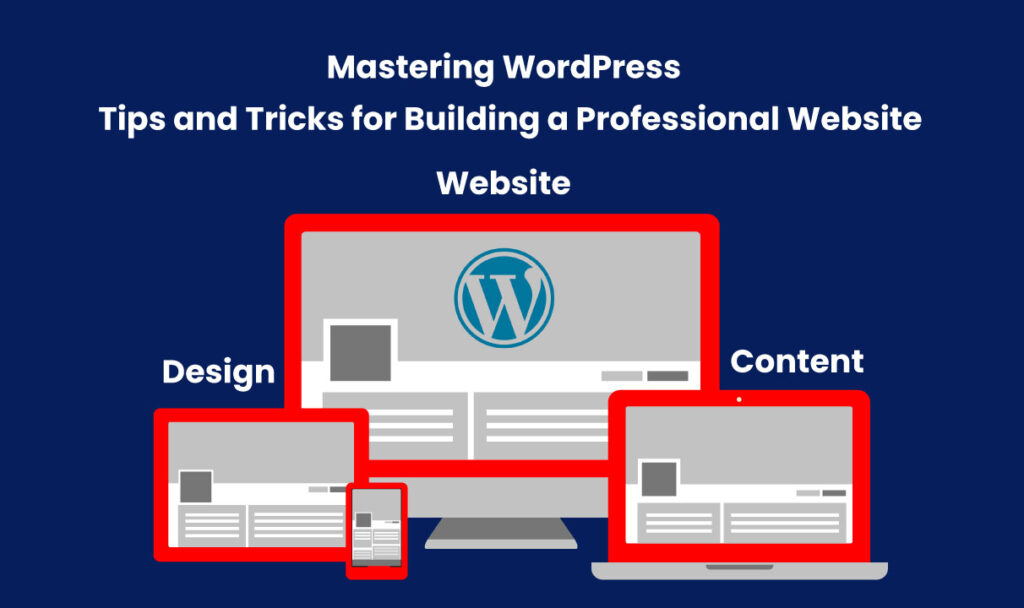18/04/2024
WordPress Website Development
WordPress has become the go-to platform for building websites due to its flexibility, ease of use, and vast array of customization options. Whether you’re a seasoned developer or a beginner, mastering WordPress can help you create stunning websites that effectively showcase your brand and engage your audience. In this blog post, we’ll explore some tips and tricks for harnessing the power of WordPress to build a professional website that stands out from the crowd.
1. Choose the Right Theme

Selecting the right theme is crucial for the overall look and functionality of your website. WordPress offers thousands of free and premium themes catering to various industries and design preferences. Consider factors such as responsiveness, customization options, and support when choosing a theme for your website. Additionally, look for themes that are regularly updated to ensure compatibility with the latest WordPress version and security patches.
2. Customize Your Design

While WordPress themes provide a great starting point, customizing your design can help differentiate your website from others using the same theme. Take advantage of WordPress’s built-in customization tools, such as the Customizer and theme options panel, to tweak colors, fonts, layouts, and other design elements to align with your brand identity. For more advanced customization, consider learning CSS or hiring a developer to implement custom styles and functionalities.
3. Optimize for Performance
A fast-loading website is crucial for user experience and search engine rankings. Optimize your WordPress website for performance by implementing best practices such as:
- Compressing images: Use image compression plugins or tools to reduce file sizes without sacrificing quality.
- Caching: Install a caching plugin to generate static HTML files and serve them to visitors, reducing server load and load times.
- Minifying CSS and JavaScript: Minimize file sizes by removing unnecessary characters and whitespace from your CSS and JavaScript files.
- Choosing a reliable hosting provider: Select a hosting provider that offers optimized WordPress hosting with features such as SSD storage, CDN integration, and automatic backups.
4. Enhance SEO with Plugins
Search engine optimization (SEO) is essential for improving your website’s visibility and driving organic traffic. WordPress offers a variety of SEO plugins, such as Yoast SEO and Rank Math, that help optimize your content for search engines. These plugins allow you to easily configure meta tags, generate XML sitemaps, optimize content readability, and more. By leveraging SEO plugins, you can ensure that your website ranks higher in search engine results pages (SERPs) and attracts more visitors.
5. Implement Security Measures
Protecting your WordPress website from security threats is paramount to safeguarding your data and maintaining trust with your audience. Take proactive measures to enhance security, such as:
- Keeping WordPress core, themes, and plugins up to date: Regularly update your WordPress installation and plugins to patch security vulnerabilities and protect against malware and hacking attempts.
- Installing security plugins: Utilize security plugins like Wordfence or Sucuri Security to monitor for suspicious activity, block malicious IPs, and strengthen login security.
- Enabling HTTPS: Encrypt data transmission between your website and visitors’ browsers by installing an SSL certificate, thereby securing sensitive information such as login credentials and payment details.
6. Regularly Back Up Your Website
Backing up your WordPress website is essential for disaster recovery in case of data loss, hacking, or server failure. Implement a robust backup strategy by scheduling regular backups of your website files and database. WordPress plugins like UpdraftPlus and BackupBuddy offer automated backup solutions with options for storing backups on remote servers or cloud storage platforms. By regularly backing up your website, you can restore it to a previous state with minimal downtime and disruption.
7. Provide Ongoing Maintenance and Support
Maintaining your WordPress website is an ongoing process that requires regular updates, monitoring, and support. Stay proactive by:
- Monitoring website performance: Keep an eye on website metrics, such as page load times, traffic trends, and conversion rates, to identify areas for improvement.
- Updating content: Refresh outdated content, add new pages or blog posts, and engage with your audience through comments and social media.
- Providing customer support: Offer timely assistance and troubleshooting to visitors experiencing issues with your website, whether it’s technical problems, broken links, or usability concerns.
8. Leverage Page Builders for Advanced Layouts
Page builders are powerful tools that allow you to create complex layouts and designs without writing a single line of code. WordPress offers several popular page builder plugins, such as Elementor, Beaver Builder, and Divi, that enable you to easily drag and drop elements to customize your pages. With these tools, you can create visually stunning designs, add advanced features like sliders and animations, and optimize your layout for both desktop and mobile devices.
9. Implement E-commerce Functionality with WooCommerceCustomize Your Design

If you’re looking to sell products or services online, WooCommerce is the ultimate e-commerce solution for WordPress. This powerful plugin seamlessly integrates with your WordPress website, allowing you to set up an online store with ease. With WooCommerce, you can create product pages, manage inventory, process payments, and handle shipping, all from within your WordPress dashboard. Whether you’re selling physical products, digital downloads, or subscriptions, WooCommerce provides the flexibility and scalability to meet your needs.
10. Harness the Power of WordPress Multisite
WordPress Multisite is a feature that allows you to create a network of interconnected websites using a single WordPress installation. This is particularly useful for organizations, businesses, or agencies that manage multiple websites or subdomains. With Multisite, you can centrally manage all your websites from a single dashboard, share themes and plugins across sites, and grant varying levels of access to different users. Whether you’re running a network of blogs, a portfolio of client websites, or a franchise operation, WordPress Multisite simplifies website management and scalability.
11. Optimize Your Website for Accessibility
Accessibility is an important consideration when designing and developing websites, as it ensures that everyone, regardless of disability, can access and interact with your content. WordPress offers several accessibility features and best practices to help you create inclusive websites, such as:
- Choosing accessible themes: Select themes that adhere to accessibility standards and provide features like keyboard navigation, skip links, and semantic HTML markup.
- Using descriptive alt text for images: Provide descriptive alternative text for images to ensure that screen readers can convey their content to visually impaired users.
- Creating accessible forms: Implement accessible form elements with clear labels, error messages, and instructions for users with disabilities.
By prioritizing accessibility in your WordPress website design, you can reach a broader audience and improve the user experience for all visitors.
12. Monitor and Analyze Website Performance
Regularly monitoring and analyzing your website’s performance is essential for identifying areas of improvement and optimizing user experience. WordPress offers various tools and plugins to track website metrics and analyze visitor behavior, such as:
- Google Analytics: Integrate Google Analytics with your WordPress website to track traffic, user engagement, conversion rates, and more.
- Jetpack: Install the Jetpack plugin to access built-in website statistics, including page views, top posts, and traffic sources, directly from your WordPress dashboard.
- Performance optimization plugins: Use performance optimization plugins like WP Rocket or W3 Total Cache to improve page load times, reduce server response times, and enhance overall website speed.
By regularly monitoring website performance metrics, you can identify trends, track progress towards your goals, and make data-driven decisions to optimize your WordPress website for success.
Conclusion
Mastering WordPress is a journey that requires continuous learning, experimentation, and adaptation to stay ahead of the curve. By incorporating these tips and tricks into your WordPress development workflow, you can build professional, feature-rich websites that captivate your audience, drive conversions, and achieve your business objectives. Whether you’re a freelancer, a small business owner, or a large enterprise, WordPress offers the tools and flexibility to bring your creative vision to life and make a lasting impact on the web.
Ready to elevate your WordPress website to the next level? Contact us today to explore our WordPress development services and take your online presence to new heights.

